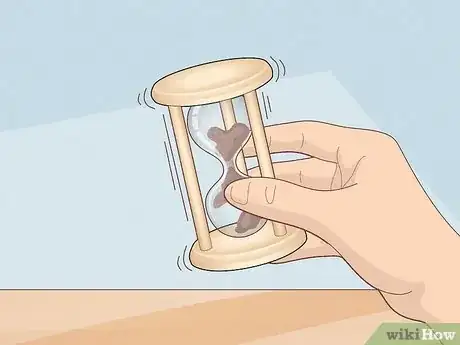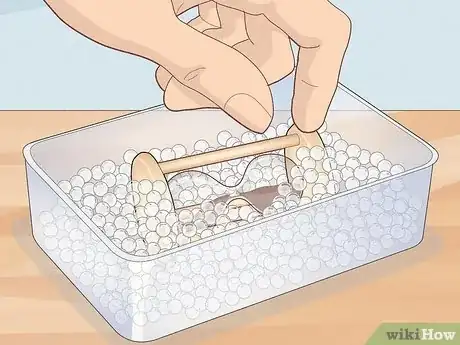This article was co-authored by wikiHow staff writer, Aly Rusciano. Aly Rusciano is a Creative Writer based outside of Nashville, Tennessee. She has over ten years of experience in creative, academic, and professional writing. Aly’s writing has been nationally recognized in the Sigma Tau Delta Rectangle and featured in Blue Marble Review, The Sunshine Review, PopMatters, and Cathartic Literary Magazine. She graduated from The University of Tennessee at Martin with a BA in English, focusing in Creative Writing and minoring in Theatre.
This article has been viewed 4,469 times.
Learn more...
There’s nothing more mesmerizing than watching the sand trickle down an hourglass, but what do you do when it gets stuck? A clogged hourglass could result from moisture building up inside the glass, causing the sand to clump and stick together. If you want to know how to fix an hourglass, have no fear! We’ve got a handful of ways you can prevent and keep your hourglass from getting stuck.
Steps
Shake the hourglass vigorously.
-
Sometimes, all your hourglass needs is a little help loosening the sand. If moisture’s built up inside an hourglass, the sand can start to stick together, forming large clumps. Break the sand apart by shaking the hourglass back and forth horizontally.
- This pushes the sand in a new direction and can help loosen clumps that formed while the sand fell vertically.
Keep the hourglass in a cool, dry space.
-
The leading cause of a clogged hourglass is humidity. When there’s high humidity, there’s high moisture. To keep your hourglass happy and trickling, store it in a cool space with balanced humidity. You can use a hygrometer to measure the humidity in your home.[1] X Trustworthy Source United States Environmental Protection Agency Independent U.S. government agency responsible for promoting safe environmental practices Go to source
- If it’s over 20 °F (−7 °C) outside, the indoor humidity should be 35%.
- If it’s over 10 °F (−12 °C) outside, the indoor humidity should be 30%.
- If it’s less than 10 °F (−12 °C) outside, the indoor humidity should be 20%.
- If it’s less than 20 °F (−7 °C) outside, the indoor humidity should be 15%.
- If you live in a climate with lots of humidity, no problem! Place a dehumidifier in the room where your hourglass sits, or turn on the air conditioner to combat excess moisture.
Blow warm air onto the hourglass with a hairdryer.
-
This can be a safe and effective way to dry wet sand. Chances are if your hourglass has condensation on the inside of the glass, it’s feeling a bit moist. You’ll need to dry out the sand to get it unstuck, and you can do that with a blow dryer. Simply put the hairdryer on the lowest setting and focus the air around the outside of the glass.[2] X Research source
- This applies a gentle and focused heat you can control.
Use silica gel to pull out moisture.
-
Silica is a desiccant, meaning it’s designed to remove moisture. Those little packets you find in packages that have “DO NOT EAT” written across them are used to moisture-proof your goods.[3] X Research source They can also help you revive your hourglass. You can either order a bag of silica gel online and submerge your hourglass in the hard beads, or seal your hourglass and a packet of silica gel in a plastic zippable storage bag.
- Silica gel can absorb 10% of water in 1 hour.[4] X Research source
- Leave your hourglass submerged for an hour, check it, and put it back in the silica gel if there is still condensation.
- Another common desiccant you may have heard of is rice. If you’ve ever gotten your phone wet and put it in a bag of rice, you’re using a desiccant.
- Rice can be used when pulling moisture from an hourglass, but it may not be strong enough to get the job done.
Bake the moisture out of an hourglass in an oven.
-
You can dry the inside of your hourglass in a 100 °F (38 °C) oven. Glass melts and molds at approximately 2,552 °F (1,400 °C).[5] X Research source However, thinner glass materials can shatter at around 302–392 °F (150–200 °C). You could potentially stick your hourglass in the oven at a very low temperature without distorting it, but check the product description or manual to make sure it's made of tempered glass.[6] X Research source
- This technique could be dangerous and should be a last resort effort to revive your hourglass.
- If you try this method, keep a close eye on your baking hourglass and remove it immediately if anything starts to burn, bend, or melt.
- Keep in mind that hourglasses can be made with all types of materials. An hourglass with a wood or plastic frame, for example, should not be placed in the oven.
Buy a new hourglass.
You Might Also Like














References
- ↑ https://www.epa.gov/mold/what-are-main-ways-control-moisture-your-home
- ↑ https://practiceadvices.com/data/advice/read/74075-how-do-you-remove-moisture-between-window-panes-on-a-hair-dryer
- ↑ https://www.discovermagazine.com/the-sciences/what-is-silica-gel-and-why-do-packets-of-it-come-with-everything-you-buy
- ↑ https://www.sciencedirect.com/topics/neuroscience/desiccants
- ↑ https://hypertextbook.com/facts/2002/SaiLee.shtml
- ↑ https://experthometips.com/can-you-put-glass-in-the-oven
About This Article



















































